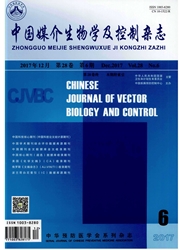

 中文摘要:
中文摘要:
目的分析元江县1995-2014年疟疾监测结果数据,为疟疾防治提供依据。方法收集元江县1995-2014年疟疾病例数、当地居民与流动人口发热患者血检数、居民带虫率、媒介种群密度等监测数据,并进行分析;其中病例诊断方法采用传统显微镜镜检法,媒介密度调查采用清晨人房或畜舍人工小时法,居民疟疾抗体水平测定采用间接荧光抗体试验。结果 1995-2014年,元江县共报告疟疾病例6 986例,其中1995年发病率最高(84.07/万,1 531例);共血检当地居民发热病例209 824例,阳性率为3.41%;共血检流动人口发热病例26 373例,阳性率为7.65%;开展居民原虫率调查51 540人,阳性率为1.56%;1997年疟疾间接荧光抗体阳性率为39.34%(769/1 955),2012年为0(0/320);微小按蚊自1995年后种群密度逐年迅速下降,与当地疟疾年发病曲线相吻合;中华按蚊1995-2002年种群密度也下降明显,但2002年之后逐渐升高。结论监测结果提示元江县今后仍需加强流动人口疟疾输入病例管理和媒介监测工作,以防止疟疾输入病例引起本地感染病例发生。
 英文摘要:
英文摘要:
Objective To analyze malaria surveillance data of Yuanjiang county of Yunnan from 1995 to 2012. Methods Data were collected from Yuanjiang county during 1995 to 2014, including malaria cases, number of resident and mobile population febrile patient blood screening, resident malaria parasitic rate, vector population density and the other data;of those malaria case was identified by tradition microscope method, malaria vector density was investigated by human hour collection mosquito in resident houses or animal shelters, and human infected malaria antibody level was tested by indirect fluorescence antibody test. Results During 1995 to 2014, total of 6 986 malaria cases were reported, in those years the highest malaria morbidity were in 1995 (84.07/10 000, 1 531 cases) and the lowest in 2012 (0 cases); total of 209 824 febrile resident patient bloods were screened, its malaria positive rate was 3.41%; total of 26 373 mobile population febrile patient bloods were tested, its malaria positive rate was 7.65%; total of 51 540 healthy residents were investigated for malaria parasite, its positive rate was 1.56%; the indirect fluorescent antibody positive rate of malaria was 39.34%(769/1 955)in 1997 but 0(0/320) in 2012; Anopheles minimus population density declined rapidly from 1995 to 2014, in consistence with annual malaria morbidity, while that of An. sinensis declined during 1995 to 2002, but increased gradually since 2002. Conclusion Above malaria monitor results suggested that imported malaria case management of mobile population and vector monitor were needed to strengthen, in order to avoid local transmissions causing by imported cases.
 同期刊论文项目
同期刊论文项目
 同项目期刊论文
同项目期刊论文
 期刊信息
期刊信息
